JVC KD-G820, KD-AR870 User Manual
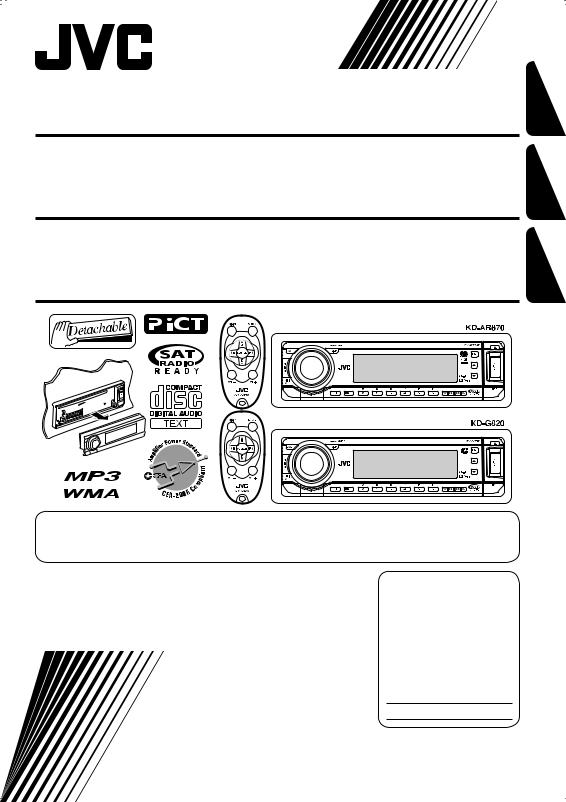
CD RECEIVER
RECEPTOR CON CD
RECEPTEUR CD
KD-AR870/KD-G820
KD-AR870/KD-G820
KD-AR870/KD-G820
FRANÇAIS ESPAÑOL ENGLISH
For canceling the display demonstration, see page 8.
Para cancelar la demostración en pantalla, consulte la página 8.
Pour annuler la démonstration des affichages, référez-vous à la page 8.
For installation and connections, refer to the separate manual. Para la instalación y las conexiones, refiérase al manual separado.
Pour l’installation et les raccordements, se référer au manuel séparé.
INSTRUCTIONS
MANUAL DE INSTRUCCIONES
MANUEL D’INSTRUCTIONS
For customer Use:
Enter below the Model No. and Serial No. which are located on the top or bottom of the cabinet. Retain this information for future reference.
Model No.
Serial No.
GET0359-001A
[J]
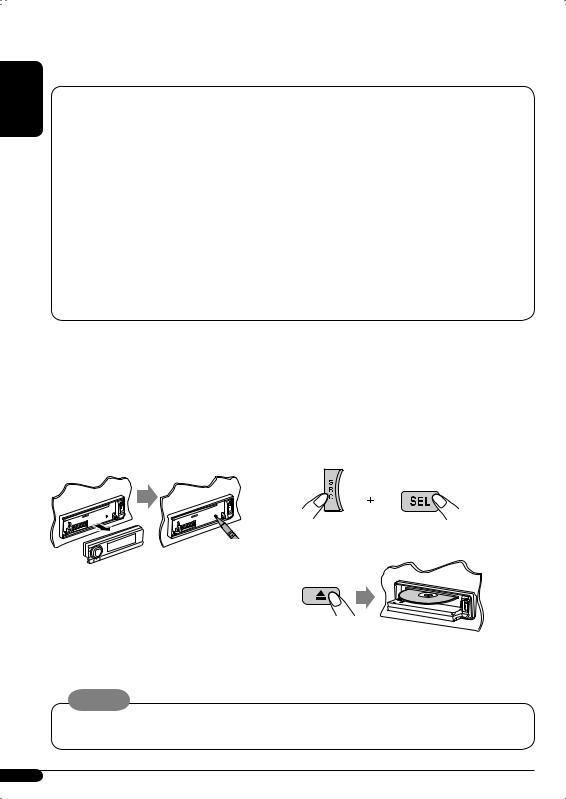
ENGLISH
Thank you for purchasing a JVC product.
Please read all instructions carefully before operation, to ensure your complete understanding and to obtain the best possible performance from the unit.
INFORMATION (For U.S.A.)
This equipment has been tested and found to comply with the limits for a Class B digital device, pursuant to Part 15 of the FCC Rules. These limits are designed to provide reasonable protection against harmful interference in a residential installation. This equipment generates, uses, and can radiate radio frequency energy and, if not installed and used in accordance with the instructions, may cause harmful interference to radio communications. However, there is no guarantee that interference will not occur in a particular installation. If this equipment does cause harmful interference to radio or television reception, which can be determined by turning the equipment off and on, the user is encouraged to try to correct the interference by one or more of the following measures:
–Reorient or relocate the receiving antenna.
–Increase the separation between the equipment and receiver.
–Connect the equipment into an outlet on a circuit different from that to which the receiver is connected.
–Consult the dealer or an experienced radio/TV technician for help.
IMPORTANT FOR LASER PRODUCTS
1.CLASS 1 LASER PRODUCT
2.CAUTION: Do not open the top cover. There are no user serviceable parts inside the unit; leave all servicing to qualified service personnel.
3.CAUTION: Visible and invisible laser radiation when open and interlock failed or defeated. Avoid direct exposure to beam.
|
|
How to reset your unit |
|
|
How to forcibly eject a disc |
||
|
|
|
|
||||
|
|
|
|
|
|
|
|
|
|
|
|
|
|
|
|
“Please Eject” appears on the display.
Your preset adjustments will also be erased.
• If this does not work, reset your unit.
• Be careful not to drop the disc when it ejects.
Caution:
Changes or modifications not approved by JVC could void the user ’s authority to operate the equipment.
2
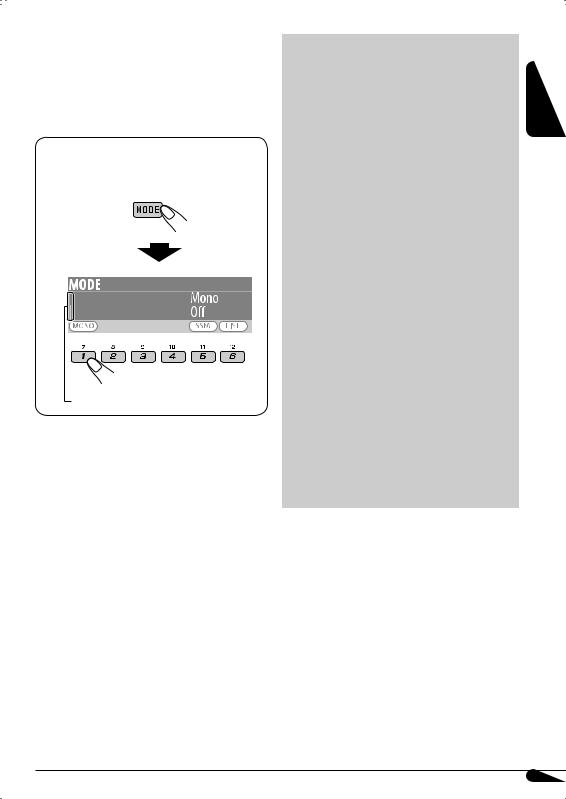
 How to use the MODE/SEL button
How to use the MODE/SEL button
If you use MODE or SEL (select), the display and some controls (such as the number buttons,  4/¢
4/¢ buttons, 5/∞buttons, and the control dial) enter the corresponding control mode.
buttons, 5/∞buttons, and the control dial) enter the corresponding control mode.
Ex.: When you press number button 1 after pressing MODE, to operate the FM tuner.
Works as time countdown indicator.
To use these controls for original functions again, wait for 15 seconds without pressing any of these buttons until the control is cleared.
•Pressing MODE again also restores original functions. However, pressing SEL makes the unit enters a different mode.
CONTENTS
Control panel — KD-AR870 and KD-G820 |
5 |
ENGLISH |
|
||
Remote controller — RM-RK50 ................. |
6 |
|
Getting started................................. |
7 |
|
Basic operations ................................................... |
7 |
|
Radio operations .............................. |
9 |
|
Disc/USB memory operations............. |
11 |
|
Playing a disc in the unit ...................................... |
11 |
|
Playing discs in the CD changer ............................ |
11 |
|
Playing a USB memory ......................................... |
12 |
|
Sound adjustments........................... |
16 |
|
General settings — PSM ................... |
18 |
|
Title assignment............................... |
27 |
|
Satellite radio operations.................. |
28 |
|
iPod®/D. player operations ................ |
32 |
|
Other external component |
|
|
operations .................................... |
34 |
|
More about this unit ......................... |
35 |
|
Maintenance .................................... |
39 |
|
Troubleshooting............................... |
40 |
|
Specifications................................... |
45 |
|
For safety...
•Do not raise the volume level too much, as this will block outside sounds, making driving dangerous.
•Stop the car before performing any complicated operations.
Temperature inside the car...
If you have parked the car for a long time in hot or cold weather, wait until the temperature in the car becomes normal before operating the unit.
3
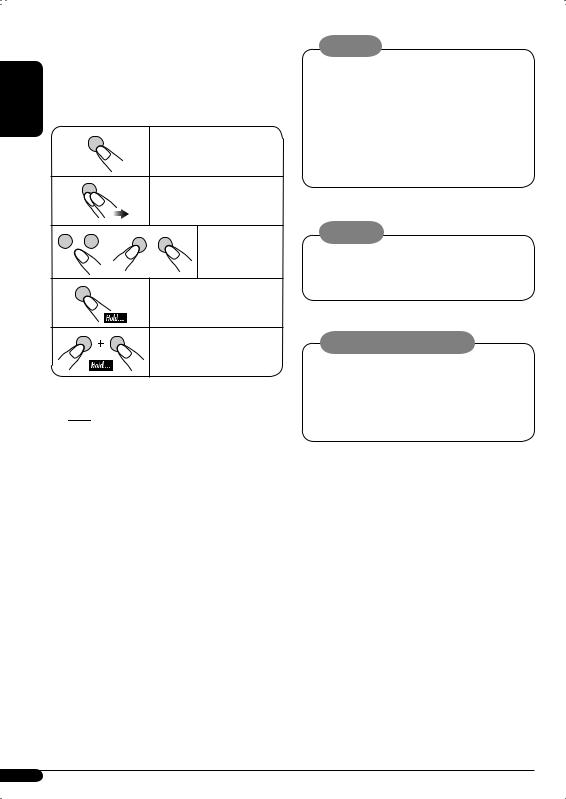
ENGLISH
 How to read this manual
How to read this manual
•Button operations are mainly explained with the illustrations in the table below.
•Some related tips and notes are explained in “More about this unit” (see pages 35 – 38).
Press briefly.
Press repeatedly.
Press either one.
Press and hold until your desired response begins.
Press and hold both buttons at the same time.
The following marks are used to indicate...
 : Built-in CD player operations.
: Built-in CD player operations.
 : External CD changer operations.
: External CD changer operations.  : External USB memory operations.
: External USB memory operations.
Caution:
If the temperature inside the car is below 0°C, the movement of animation and text scroll will be halted on the display to prevent the display from being blurred.  appears on the display.
appears on the display.
When the temperature increases, and the operating temperature is resumed, these functions will start working again.
Warning:
If you need to operate the unit while driving, be sure to look ahead carefully or you may be involved in a traffic accident.
Caution on volume setting:
Discs produce very little noise compared with other sources. Lower the volume before playing a disc to avoid damaging the speakers by the sudden increase of the output level.
4
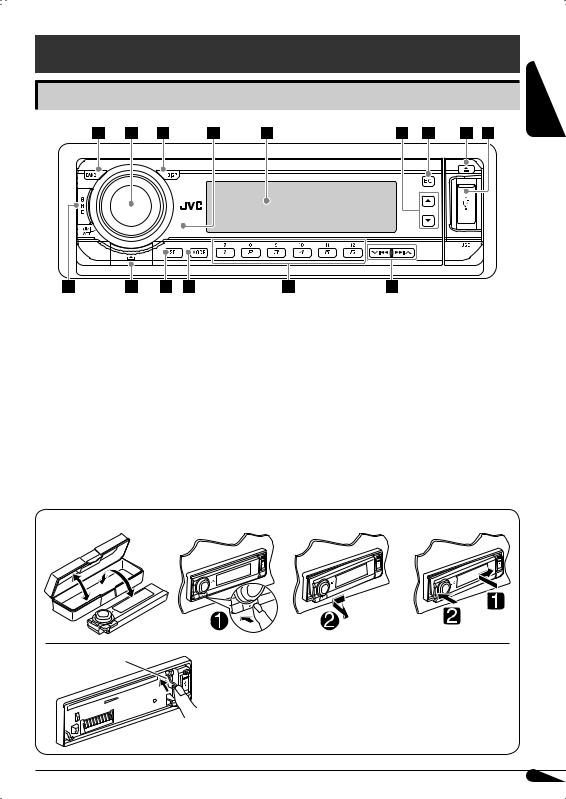
Control panel — KD-AR870 and KD-G820
Parts identification
ENGLISH
1 BAND button
2• Control dial
•


 (standby/on attenuator) button 3 DISP (display) button
(standby/on attenuator) button 3 DISP (display) button
4 Remote sensor
•DO NOT expose the remote sensor to strong light (direct sunlight or artificial
lighting).
5 Display window
6 5(up) / ∞(down) buttons
7 EQ (equalizer) button
8 0(eject) button
9 USB (Universal Serial Bus) input terminal p SRC (source) button
q  (control panel release) button w SEL (select) button
(control panel release) button w SEL (select) button
e MODE button r Number buttons
t  4/¢
4/¢ buttons
buttons
 How to detach/attach the control panel
How to detach/attach the control panel
Detaching... |
Attaching... |
Lever |
CAUTION: |
The lever comes out if you pressed the 0button while the panel is detached. If this happens, push the lever back into lock position before attaching the panel.
5

Remote controller — RM-RK50
ENGLISH |
|
Installing the lithium coin battery |
|
||
|
|
|
|
|
(CR2025) |
Aim the remote controller directly at the remote sensor on the unit. Make sure there is no obstacle in between.
Warning:
•Do not install any battery other than CR2025 or its equivalent; otherwise, it may explode.
•Store the battery in a place where children cannot reach to avoid risk of accident.
•To prevent the battery from over-heating, cracking, or starting a fire:
–Do not recharge, short, disassemble, heat the battery, or dispose of it in a fire.
–Do not leave the battery with other metallic materials.
–Do not poke the battery with tweezers or similar tools.
–Wrap the battery with tape and insulate when throwing away or saving it.
Caution:
Main elements and features
1
 (standby/on/attenuator) button
(standby/on/attenuator) button
•Turns the power on if pressed briefly or attenuates the sound when the power is on.
•Turns the power off if pressed and held. 2 5U (up) / D (down) ∞buttons
•Changes the FM/AM bands with 5U.
•Changes the preset stations with D ∞.
•Changes the folder of the MP3/WMA/ USB.
•While playing an MP3 disc on an MP3-compatible CD changer:
–Changes the disc if pressed briefly.
–Changes the folder if pressed and held.
•While listening to the satellite (SIRIUS or XM) radio:
–Changes the categories.
6
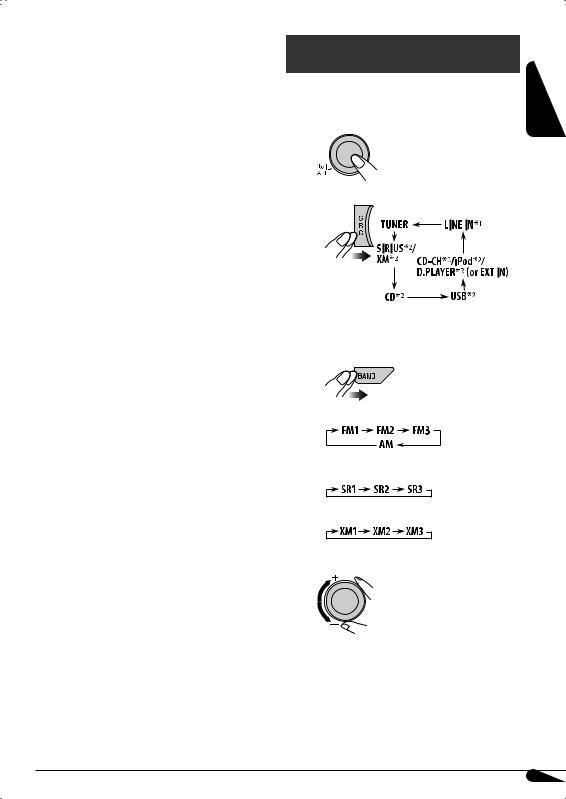
•While listening to an Apple iPod® or a JVC D. player:
–Pauses/stops or resumes playback with D ∞.
–Enters the main menu with 5U. (Now
5U/D ∞/2R/F 3work as the menu selecting buttons.)*
3VOL – / VOL + buttons
•Adjusts the volume level. 4 SOUND button
•Selects the sound mode (i-EQ: intelligent equalizer).
5SOURCE button
• Selects the source.
62R (reverse) / F (forward) 3buttons
•Searches for stations if pressed briefly.
•Fast-forwards or reverses the track if pressed and held.
•Changes the tracks if pressed briefly.
•While listening to the satellite radio:
–Changes the channels if pressed briefly.
–Changes the channels rapidly if pressed and held.
•While listening to an iPod or a D. player (in menu selecting mode):
–Selects an item if pressed briefly. (Then, press D ∞to confirm the selection.)
–Skips 10 items at a time if pressed and held.
*5U: Returns to the previous menu. D ∞: Confirms the selection.
Getting started
Basic operations |
|
ENGLISH |
|
|
|
|
|
|
~ Turn on the power. |
|
|
Ÿ
*1 Only for KD-AR870.
*2 You cannot select these sources if they are not ready or not connected.
!
•For FM/AM tuner
•For SIRIUS tuner
•For XM tuner
⁄Adjust the volume.
@Adjust the sound as you want. (See pages 16 – 18.)
Continued on next page...
7
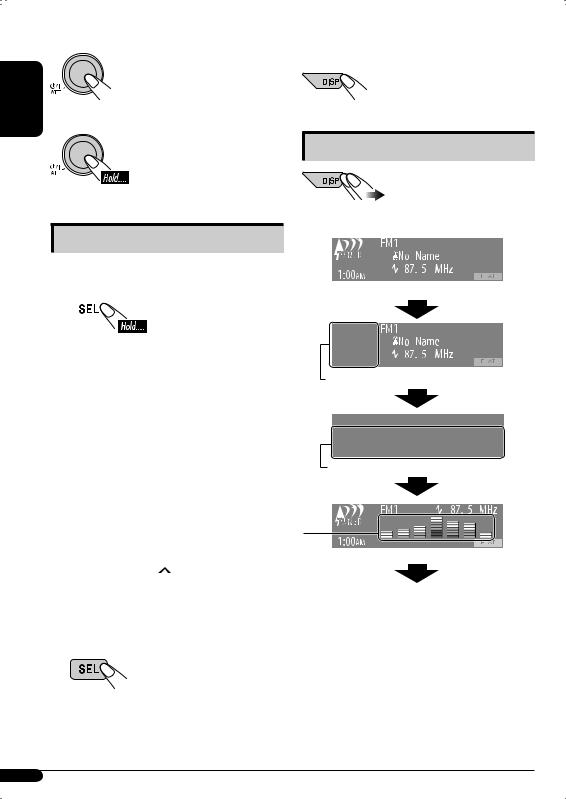
ENGLISH
To drop the volume in a moment (ATT)
To restore the sound, press it again.
To turn off the power
Basic settings
•See also “General settings — PSM” on pages 18 – 21.
1 
2-1 Canceling the display demonstrations
Turn the control dial to set “Demo/Link” to “Off.”
2-2 Setting the clock
1Press number button 4 ( ). “Clock Hr” (hour) appears. Then, turn the control dial to adjust the hour.
). “Clock Hr” (hour) appears. Then, turn the control dial to adjust the hour.
2Press ¢ to select “Clock Min” (minute). Then, turn the control dial to adjust the minute.
to select “Clock Min” (minute). Then, turn the control dial to adjust the minute.
3 Press ¢ to select “24H/12H.” Then, turn the control dial to select “12Hours” or “24Hours,” time display mode.
3 Exit from the setting.
To check the current clock time when the power is turned off
Changing the display pattern
Ex.: When tuner is selected as the source
Source operation display
“SMALL” (CD jacket image) graphic*1 is displayed.
 *2
*2
“LARGE” (full display size) graphic*1 is displayed.
 Audio level meter is displayed (see “LevelMeter” on page 19).
Audio level meter is displayed (see “LevelMeter” on page 19).
Goes back to the initial display pattern.
*1 You can use your edited file for graphic screen (see pages 22 – 25).
Depending on a downloaded file, it may take a longer time to show it on the display.
*2 The information bar will disappear if no operation is performed for five seconds.
8
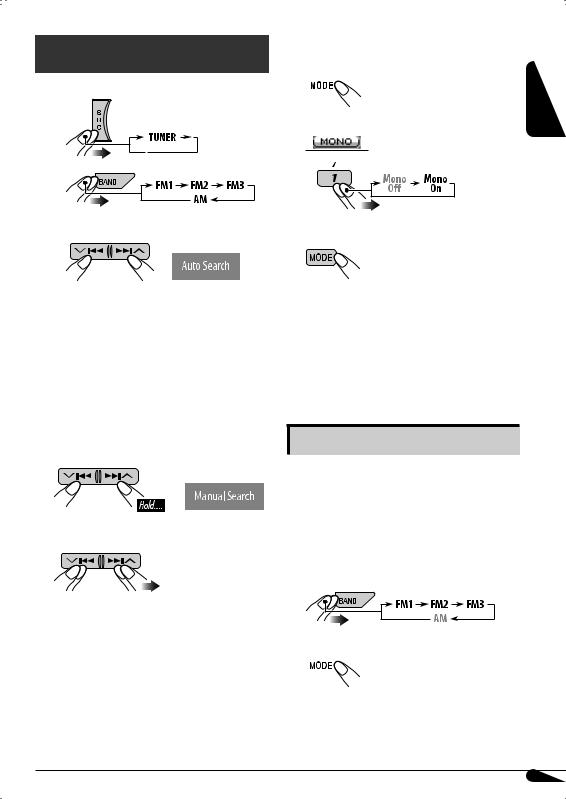
Radio operations
~
Ÿ
!Start searching for a station.
When a station is received, searching stops.
•When receiving an FM stereo broadcast with sufficient signal strength,  lights up on the display.
lights up on the display.
To stop searching, press the same button again.
When an FM stereo broadcast is hard to receive
1 
2
3 Exit from the setting.
 lights up on the display. Reception improves, but stereo effect will be lost.
lights up on the display. Reception improves, but stereo effect will be lost.
To restore the stereo effect, select “Mono Off” in step 2.  goes off.
goes off.
To tune in to a station manually
In step ! above...
1
2 Select a desired station frequency.
Storing stations in memory
You can preset six stations for each band.
 FM station automatic presetting— SSM (Strong-station Sequential Memory)
FM station automatic presetting— SSM (Strong-station Sequential Memory)
1Select the FM band (FM1 – FM3) you want to store into.
ENGLISH
2 
Continued on next page...
9
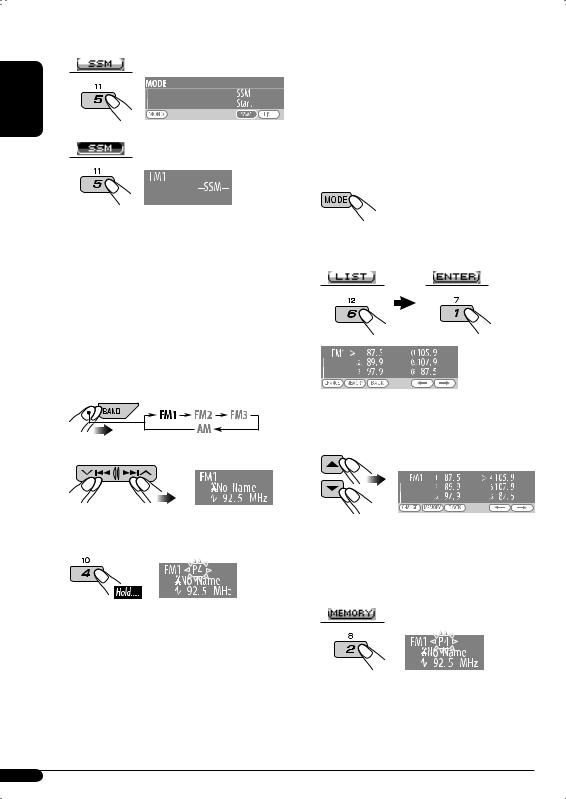
3 Select “SSM.”
ENGLISH
4
Local FM stations with the strongest signals are searched and stored automatically in the FM band.
 Manual presetting
Manual presetting
Ex.: Storing FM station of 92.5 MHz into preset number 4 of the FM1 band.
Using the number buttons
1
2
3
Using the Preset Station List
•When  appears on the display, you can move back to the previous display by pressing number button 3.
appears on the display, you can move back to the previous display by pressing number button 3.
1Follow steps 1 and 2 on left column.
•By holding 5/ ∞, the Preset Station List will appear (go to step 4 below).
2
3 Display the Preset Station List.
4Select the preset number you want to store into.
•You can move to the lists of the other FM bands by pressing number button 5
( ) or 6 (
) or 6 ( ) repeatedly.
) repeatedly.
5 Store the station.
10
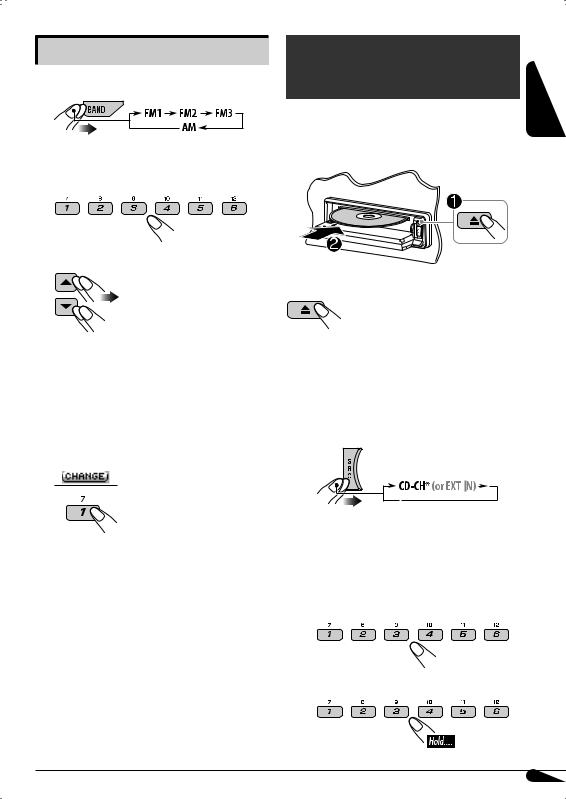
Listening to a preset station
Using the number buttons
1
2Select the preset station (1 – 6) you want to listen to.
or
Using the Preset Station List
1Display the Preset Station List, then select the preset station you want to listen to.
2 Change to the selected station.
Disc/USB memory
operations |
|
ENGLISH |
|
|
|
Playing a disc in the unit |
|
|
|
|
|
|
|
All tracks will be played repeatedly until you change the source or eject the disc.
To stop playback and eject the disc
Playing discs in the CD changer 
All discs in the magazine will be played repeatedly until you change the source.
• Ejecting the magazine will also stop playback.
~
*If you have changed the external input setting to “Ext In” (see page 21), you cannot select the CD changer.
ŸSelect a disc.
For disc number from 01 – 06:
For disc number from 07 – 12:
11

|
Playing a USB memory |
|
|
|
|
|
|
|
ENGLISH |
This unit can play MP3/WMA tracks stored in a |
|
• Removing the USB memory will also stop |
||
|
USB memory. |
|
|
All tracks in the USB memory will be played |
|
|
repeatedly until you change the source. |
|
|
playback. |
|
|
~ |
|
Ÿ |
USB input terminal |
USB memory
If a USB memory has been attached...
Playback starts from where it has been stopped previously.
•If a different USB memory is currently attached, playback starts from the beginning.
To detach the USB memory, straightly pull it out from the unit.
Cautions:
•Avoid using the USB memory if it might hinder your safety driving.
•Make sure all the important data has been backed up to avoid losing the data.
Track and folder information (CD/CD Text/ MP3/WMA/USB)
Once you insert a disc or attach a USB memory, the total track number/total playing time (for CD/CD Text) and total folder number/total track number (for MP3/ WMA/USB) appears, then the following information appears...
Ex.: When “CD-CH” is selected as the source
Current folder number*1
Current disc number*2 |
Elapsed playing time |
|||||||||
|
File type*1*3 |
|
Current |
track number |
|
|||||
|
|
|
|
|
|
|
|
|
|
|
|
|
|
|
|
|
|
|
|
|
|
|
|
|
|
|
|
|
|
|
|
|
•For the audio CD or CD Text:
 Disc name*4 and
Disc name*4 and  Track name*5
Track name*5
•For the MP3/WMA/USB:
 Folder name and
Folder name and  File name, or
File name, or
 Album/performer*6 and
Album/performer*6 and  Track name*6
Track name*6
•When playing CD changer, the total numbers will not appear.
*1 Displayed only when an MP3/WMA track is played back.
*2 Displayed only when “CD-CH” is selected as the source.
*3 Either MP3 or WMA indicator lights up depending on the detected file.
*4 Appears only for CD Texts and CDs if it has been recorded or assigned. (“No
Name” appears if no name is recorded or assigned.)
*5 Appears only for CD Texts. (“No Name” appears if no name is recorded.)
*6 Appears only when “Tag” is set to “On” (see page 20).
12
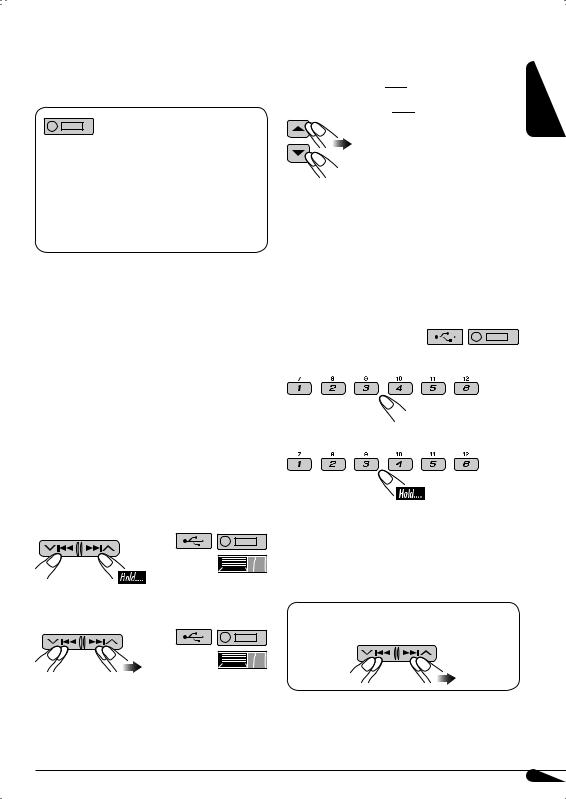
About MP3 and WMA tracks
MP3 and WMA “tracks” (words “file” and “track” are used interchangeably) are recorded in “folders.”
When an MP3/WMA folder in an MP3/ WMA disc includes an image <jtw> file edited by Image Converter (Ver 3.0)— supplied in the CD-ROM, you can show the image on the display while the tracks in the folder are played back—Image Link. (See pages 19 and 37 for details.)
About the CD changer
It is recommended to use a JVC MP3compatible CD changer with your unit.
•You can also connect MP3-incompatible CD changers. These units, however, are not compatible with MP3 discs.
•You cannot use the CH-X99, CH-X100, and KD-MK series CD changers with this unit.
•You cannot play any WMA disc in the CD changer.
•Disc text information recorded in the CD Text can be displayed when a JVC CD Text compatible CD changer is connected.
•For connection, see Installation/Connection Manual (separate volume).
To fast-forward or reverse the track
To go to the next or previous tracks
To go to the next or previous folders (only for MP3/WMA/USB)
For MP3 tracks:

 For WMA tracks:
For WMA tracks:

ENGLISH
For the main unit:
•Holding either of the buttons can display the Folder List (see page 14).
For CD changer:
•Holding either of the buttons can display the Disc List (see page 14).
To locate a particular track (for CD) or folder (for MP3/WMA/USB) directly
To select a number from 01 – 06:
To select a number from 07 – 12:
•To use direct folder access on MP3/WMA/ USB, it is required that folders are assigned with 2-digit numbers at the beginning of their folder names—01, 02, 03, and so on.
To select a particular track in a folder (for MP3/WMA/USB):
13

|
|
|
|
Other main functions |
||
ENGLISH |
|
|
Selecting a disc/folder/track on the list |
|||
|
|
|||||
|
|
|
||||
|
|
|
|
|
||
|
|
|
|
|
|
|
|
|
|
|
|
|
|
|
|
|
|
|
|
|
|
• When |
|
appears on the display, you can |
|||
|
move back to the previous display by pressing |
|||||
|
number button 3. |
|||||
1 
2 Select “LIST.”
3 Select the list type.
*1 Selectable only when the source is “CD-CH.”
*2 Selectable only when the media is MP3, WMA, or USB.
4 Select an item.
EX.: When “File” is selected in step 3
• You can move to the other lists by pressing number button 5 ( ) or 6 (
) or 6 ( ) repeatedly.
) repeatedly.
5 Change to the selected item.
• The list disappears and playback starts.
 Skipping tracks quickly during play
Skipping tracks quickly during play
Only possible on JVC
MP3-compatible CD changer
•For MP3/WMA/USB, you can skip tracks within the same folder.
Ex.: To select track 32 while playing a track whose number is a single digit (1 to 9).
1 
2 
Each time you press the button, you can skip 10 tracks.
•After the last track, the first track will be selected and vice versa.
3 
14
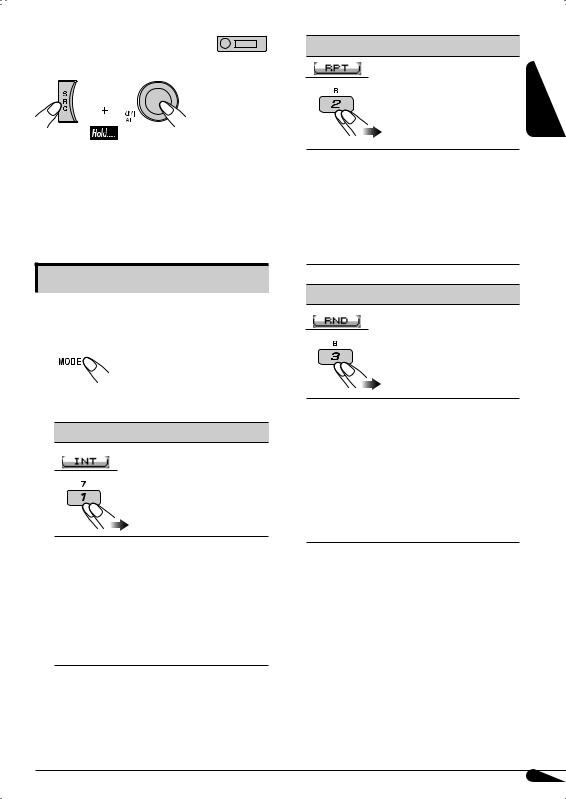
 Prohibiting disc ejection
Prohibiting disc ejection
You can lock a disc in the loading slot.
• “No Eject” appears on the display.
To cancel the prohibition, repeat the same procedure.
• “Eject OK” appears on the display.
Selecting the playback modes
You can use only one of the following playback modes at a time.
7 Repeat play
ENGLISH
Mode |
Plays repeatedly |
Track: The current track [ ]. Folder*1: All tracks of the current folder
]. Folder*1: All tracks of the current folder
[ ].
].
Disc*2: All tracks of the current disc [ ].
].
Off: Cancels.
7 Random play
1 
2Select your desired playback mode.
7 Intro play
Mode |
Plays beginning 15 seconds of... |
Track: All tracks of the current disc or USB memory [ ].
].
Folder*1: First tracks of all folders [ ].
].
Disc*2: First tracks of all the inserted discs [ ].
].
Off: Cancels.
Mode |
Plays at random |
Folder*1: All tracks of the current folder, then tracks of the next folder and so on [ ].
].
Disc*3: All tracks of the current disc [ ].
].
All*4: All tracks of the inserted discs or USB memory [ ].
].
Off: Cancels.
*1 Only while playing a media (MP3/WMA/ USB).
*2 Only while playing discs in the CD changer.
*3 Only while playing a disc.
*4 Only while playing discs in the CD changer or playing a USB memory.
•You can also cancel the playback mode by pressing number button 4 ( ) in step 2.
) in step 2.
15
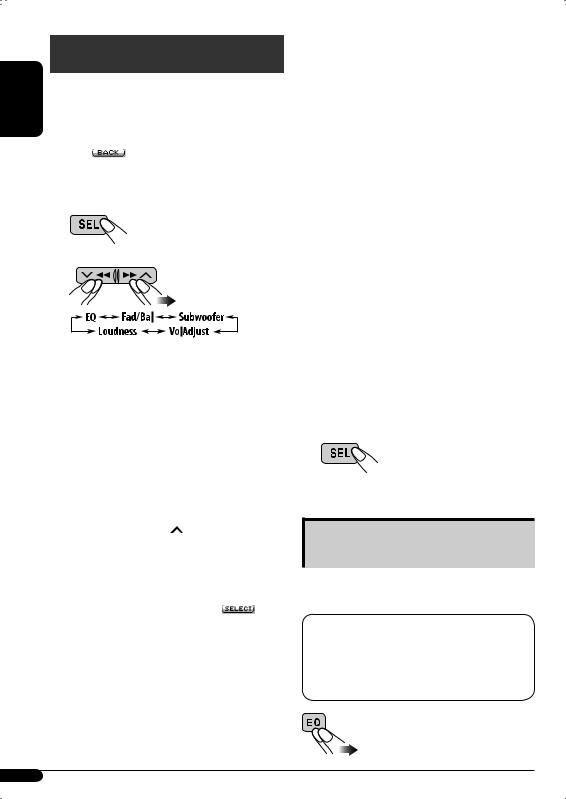
Sound adjustments
ENGLISH |
|
|
|
|
|
|
You can adjust the sound characteristics to your |
||||
|
|
|
|
Adjusting the sound |
|
|
preference. |
|
|
||
|
• When |
appears on the display, you can |
|||
|
|
move back to the previous display by pressing |
|||
|
|
number button 3. |
|||
|
1 |
|
|
|
|
|
2 |
|
|
|
|
|
|
|
|
||
• For “EQ” setting, see the following.
3 Adjust the selected setting item.
A Fad/Bal (Fader/Balance)
1 Press number button 1 ( ) to move to the “Fad/Bal” adjustment display.
) to move to the “Fad/Bal” adjustment display.
2 Adjust the speaker output balance by pressing:
5/ ∞: between the front and rear speakers. [F06 to R06]
 4/¢ :
4/¢ :
between the left and right speakers. [L06 to R06]
B Subwoofer |
|
1 Press number button 1 ( |
) to |
move to the “Subwoofer” adjustment display.
2Use  4/¢
4/¢ to select a cutoff frequency to the subwoofer.
to select a cutoff frequency to the subwoofer.
•80Hz: Frequencies higher than 80 Hz are cut off.
•120Hz: Frequencies higher than 120 Hz are cut off.
•160Hz: Frequencies higher than 160 Hz are cut off.
3Turn the control dial to adjust the subwoofer output level. [0 to 8]
CVolAdjust
Turn the control dial to adjust the input level of each source (except FM).
[–5 to +5]
Adjust to match the input level of the FM sound level.
•Before making an adjustment, select a source you want to adjust.
DLoudness
Turn the control dial to activate or deactivate the loudness to produce a well-balanced sound at low volume levels. [Off or On]
4 Exit from the setting.
Selecting preset sound modes (i-EQ: intelligent equalizer)
You can select a preset sound mode suitable to the music genre.
Available sound modes
FLAT (No sound mode is applied), H.ROCK (Hard rock), R & B (Rhythm & blues),
POP, JAZZ, DANCE, COUNTRY, REGGAE, CLASSIC, USER 1, USER 2, USER 3
16

Storing your own sound modes
You can adjust the sound modes and store your own adjustments in memory.
•When  appears on the display, you can move back to the previous display by pressing number button 3.
appears on the display, you can move back to the previous display by pressing number button 3.
1 
or
Follow steps 1 and 2 on page 16.
• In step 2, select “EQ.”
2 Select a sound mode.
To display the rest
3 Select a frequency range.
4Adjust the sound elements of the selected frequency range.
1 Use 5 / ∞ to adjust the level.
2 Press number button 2 ( ), then turn the control dial to select the frequency.
), then turn the control dial to select the frequency.
3 Press number button 2 ( ), then turn the control dial to select the band width.
), then turn the control dial to select the band width.
Sound |
Range/selectable items |
||
elements |
Low |
Mid |
High |
|
|
|
|
Level |
–06 to |
–06 to |
–06 to |
|
+06 |
+06 |
+06 |
FREQ |
60 Hz |
500 Hz |
10 kHz |
(Frequency) |
80 Hz |
1 kHz |
12.5kHz |
|
100 Hz |
1.5kHz |
15 kHz |
|
200 Hz |
2.5kHz |
17.5kHz |
Q (Band |
Q1.0 |
Q0.5 |
Fix |
width) |
Q1.25 |
Q0.75 |
|
|
Q1.5 |
Q1.0 |
|
|
Q2.0 |
Q1.25 |
|
5Repeat steps 3 and 4 to adjust other frequency ranges.
6 Store the adjustments.
ENGLISH
17
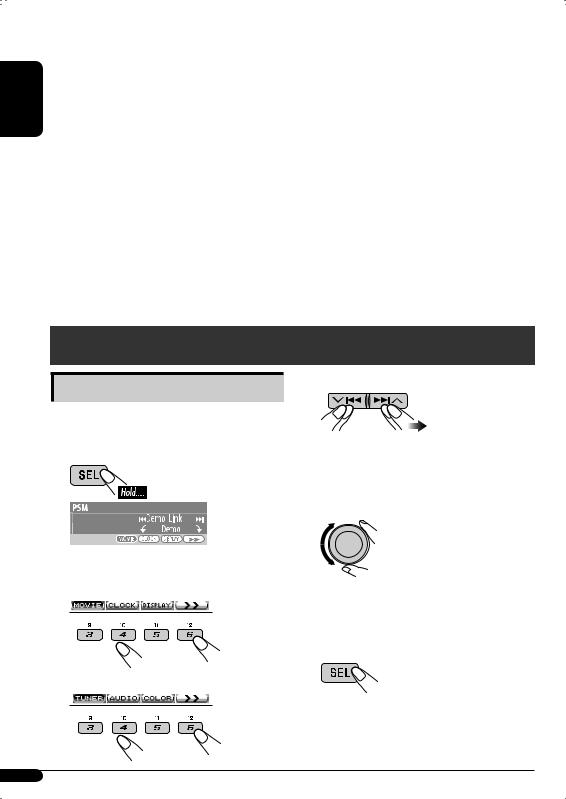
ENGLISH
The list below shows the preset value setting for each sound mode:
|
|
|
|
|
Preset values |
|
|
|
|
|
|
|
|
|
|
|
|
|
|
|
|
Sound |
|
Low |
|
|
Mid |
|
|
High |
|
|
modes |
|
|
|
|
|
|
|
|
|
|
Level |
FREQ |
Q (Band |
Level |
FREQ |
|
Q (Band |
Level |
FREQ |
Q (Band |
|
|
|
|||||||||
|
|
(Frequency) |
width) |
|
(Frequency) |
|
width) |
|
(Frequency) |
width) |
FLAT |
00 |
60 Hz |
Q1.25 |
00 |
1 kHz |
|
Q1.25 |
00 |
10 kHz |
|
H.ROCK |
+03 |
100 Hz |
Q1.0 |
00 |
1 kHz |
|
Q1.25 |
+02 |
10 kHz |
|
R & B |
+03 |
80 Hz |
Q1.25 |
+01 |
1 kHz |
|
Q1.25 |
+03 |
15 kHz |
|
POP |
+02 |
100 Hz |
Q1.25 |
+01 |
1 kHz |
|
Q1.25 |
+02 |
10 kHz |
|
JAZZ |
+03 |
80 Hz |
Q1.25 |
00 |
1 kHz |
|
Q1.25 |
+03 |
10 kHz |
Fix |
DANCE |
+04 |
60 Hz |
Q1.0 |
-02 |
1 kHz |
|
Q1.0 |
+01 |
10 kHz |
|
COUNTRY |
+02 |
60 Hz |
Q1.0 |
00 |
1 kHz |
|
Q1.0 |
+02 |
12.5kHz |
|
REGGAE |
+03 |
60 Hz |
Q1.25 |
+02 |
1 kHz |
|
Q1.25 |
+02 |
12.5kHz |
|
CLASSIC |
+01 |
80 Hz |
Q1.25 |
00 |
1 kHz |
|
Q1.25 |
+03 |
10 kHz |
|
General settings — PSM
Basic procedure
You can change PSM (Preferred Setting Mode) items listed (except “Sirius ID”) in the table that follows.
1
An item previously selected appears on the display.
2 Select a PSM category.
To display the rest 
3 Select a PSM item.
•By pressing either of the buttons repeatedly, you can also move to the item of the other categories.
4 Adjust the selected PSM item.
5Repeat steps 2 to 4 to adjust other PSM items if necessary.
6 Exit from the setting.
18

Category |
Indications |
Selectable settings, [reference page] |
|
||
|
|
Demo/Link |
Demo: |
[Initial]; Display demonstration will be |
|
|
|
Display |
|
activated automatically, [8]. |
|
|
|
demonstration |
Image Link: |
To show a still image while playing MP3/ |
|
|
|
|
|
WMA tracks, [13, 37]. |
|
|
|
|
Off: |
Cancels. |
|
|
MOVIE |
|
• Still image appears if no operation is done for about |
||
|
|
20 seconds. |
|
|
|
|
|
|
|
|
|
|
|
LevelMeter |
You can select the different level meter patterns. |
||
|
|
Audio level meter |
Meter 1 [Initial] OMeter 2 |
|
|
|
|
|
• Press DISP repeatedly to show the selected level meter. |
||
|
|
Pict |
Download: |
[Initial]; Download files, [22]. |
|
|
|
Pictures |
Set: |
Activate the stored files, [25] |
|
|
|
|
Delete: |
Delete the stored files, [23]. |
|
|
|
Clock Hr |
1 – 12AM/1 – 12PM (0 – 23), [8] |
|
|
|
|
Hour adjustment |
[Initial: 1 (1:00AM)] |
|
|
|
|
Clock Min |
00 – 59, [8] |
|
|
|
|
Minute adjustment |
[Initial: 00 (1:00AM)] |
|
|
|
|
24H/12H |
12Hours – 24Hours, [8] |
|
|
|
|
Time display mode |
[Initial: 12Hours] |
|
|
|
|
Clock Adj*1 |
Auto: |
[Initial]; The built-in clock is automatically |
|
|
CLOCK |
Automatic clock |
Off: |
adjusted using the clock data provided via |
|
|
adjustment |
Cancels. |
|
||
|
|
|
the satellite radio channel. |
|
|
|
|
Time Zone*1*2 |
Select your residential area from one of the following time |
||
|
|
Time zone |
zones for clock adjustment. |
|
|
|
|
|
Eastern [Initial] OAtlantic ONewfndlnd (Newfoundland) |
||
|
|
|
OAlaska OPacific OMountain OCentral O(back to |
||
|
|
|
the beginning) |
|
|
|
|
DST*1*2 |
Activate this if your residential area is subject to DST. |
||
|
|
Daylight saving time |
On: |
[Initial]; Activates daylight savings time. |
|
|
|
|
Off: |
Cancels. |
|
|
DISPLAY |
Scroll |
Once: |
[Initial]; Scrolls the track information once. |
|
|
Scroll |
• Pressing DISP for more than one second can scroll the |
|||
|
|
Auto: |
Repeats scrolling (5-second intervals). |
||
|
|
|
Off: |
Cancels. |
|
|
|
|
display regardless of the setting. |
|
|
*1 |
Displayed only when SIRIUS Satellite radio or XM Satellite radio is connected. |
|
|||
*2 |
Adjustable only when “Clock Adj” is set to “Auto.” Press number button 1 ( |
) to show the |
|||
|
setting display. |
|
|
|
|
Continued on next page...
ENGLISH
19

ENGLISH
Category |
Indications |
Selectable settings, [reference page] |
|
|
Dimmer |
Auto: |
[Initial]; Dims the display when you turn on |
|
Dimmer |
|
the headlights. |
|
|
Off: |
Cancels. |
|
|
On: |
Activates dimmer. |
|
|
Time Set: |
Set the timer for dimmer, [25]. |
|
|
Any hour – Any hour |
|
|
From – To*3: |
[Initial: 6PM – 7AM] |
|
|
Contrast |
1 – 10: |
[Initial: 5]; Adjust the display contrast to |
|
Contrast |
|
make the display indications clear and |
DISPLAY |
|
|
legible. |
Display type |
Negative: |
(except still images and animation). |
|
|
LCD Type |
[Initial]; Negative pattern of the display |
|
|
|
Auto: |
Positive pattern will be selected during the |
|
|
|
day time*4; while negative pattern will be |
|
|
|
used during the night time*4. |
|
|
Positive: |
Positive pattern of the display. |
|
Font Type |
You can select the font type used on the display. |
|
|
Font type |
1 [Initial] O2 |
|
|
Tag |
On: |
[Initial]; Shows the Tag information display |
|
Tag display |
|
while playing MP3/WMA tracks, [12]. |
|
|
Off: |
Cancels. |
|
IF Band |
Auto: |
[Initial]; Increases the tuner selectivity to |
|
Intermediate |
|
reduce interference noises between close |
|
frequency filter |
|
stations. (Stereo effect may be lost.) |
|
|
Wide: |
Subject to the interference noises from |
|
|
|
adjacent stations, but sound quality will |
|
|
|
not be degraded and the stereo effect will |
|
|
|
remain. |
TUNER |
AreaChange |
US |
[Initial]; When using in North/Central/ |
interval |
|
10 kHz/200 kHz. |
|
|
Tuner channel |
|
South America. AM/FM intervals are set to |
|
|
SA |
When using in South American countries |
|
|
|
where FM interval is 100 kHz. AM interval is |
|
|
|
set to 10 kHz. |
|
|
EU |
When using in any other areas. AM/FM |
|
|
|
intervals are set to 9 kHz/50 kHz (100 kHz |
|
|
|
during auto search). |
|
Sirius ID*5 |
The 12-digits SIRIUS identification number appears on the |
|
|
SIRIUS ID |
display, [28]. |
|
20

Category Indications |
Selectable settings, [reference page] |
||
|
Ext Input*6 |
Changer: |
[Initial]; To use a JVC CD changer, [11], a |
|
External input |
|
JVC compatible satellite (SIRIUS/XM) tuner, |
|
|
|
[28], an Apple iPod, or a JVC D. player, [32]. |
|
|
Ext In: |
To use any other external component than |
|
|
|
the above, [34]. |
|
Beep |
On: |
[Initial]; Activates the key-touch tone. |
|
Key-touch tone |
Off: |
Deactivates the key-touch tone. |
AUDIO |
Telephone*7 |
Muting1/Muting2: Select either one which mutes the |
|
Telephone muting |
|
sounds while using a cellular phone. |
|
|
Off: |
[Initial]; Cancels. |
|
•If CD, CD changer, or USB memory has been selected as the source, playback pauses during telephone muting.
|
|
Amp Gain |
You can change the maximum volume level of this unit. |
|
|
|
Amplifier gain |
High PWR: |
[Initial]; Volume 00 – Volume 50 |
|
|
control |
Low PWR: |
Volume 00 – Volume 30 (Select this if the |
|
|
|
|
maximum power of the speaker is less than |
|
|
|
|
50 W to prevent them from being damaged.) |
|
|
|
Off*7: |
Deactivates the built-in amplifier. |
|
|
Color Sel |
[Initial: All Source]; You can select your favorite display color |
|
|
|
Color selection |
for each source (or for all sources), [25]. |
|
|
|
Color Set |
You can create your own colors, and select them for the |
|
|
COLOR |
display color, [26]. |
||
|
Day Color: |
User color during the day time*4. |
||
|
NightColor: |
User color during the night time*4. |
||
|
|
|
||
|
|
Red |
+00 – +11 [Initial: Day Color: +07, NightColor: +05] |
|
|
|
Green |
+00 – +11 [Initial: Day Color: +07, NightColor: +05] |
|
|
|
Blue |
+00 – +11 [Initial: Day Color: +07, NightColor: +05] |
|
*3 |
Adjustable only when “Dimmer” is set to “Time Set.” |
|
||
*4 |
Depends on the “Dimmer” setting. |
|
|
|
*5 |
Displayed only when SIRIUS Satellite radio is connected. |
|||
*6 |
Displayed only when one of the following sources is selected—TUNER, CD, USB, or LINE IN (only |
|||
|
for KD-AR870). |
|
|
|
*7 |
Only for KD-AR870. |
|
|
|
ENGLISH
21
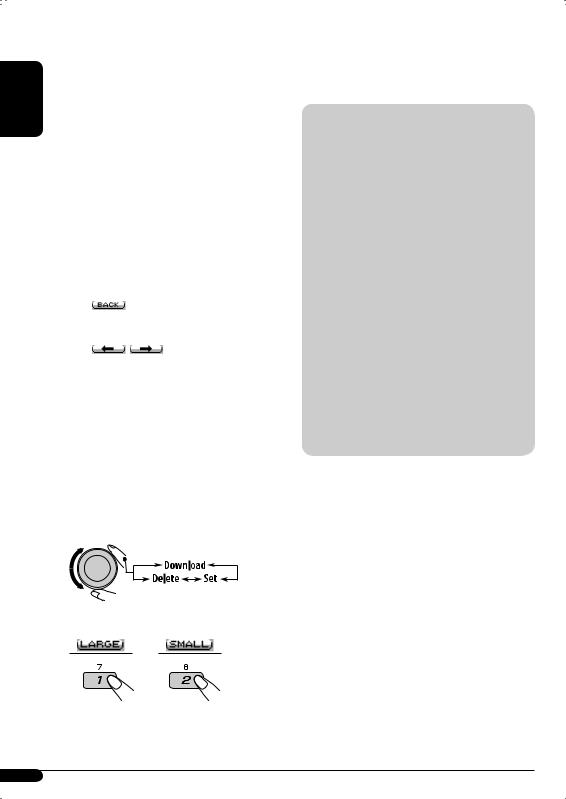
|
|
|
Graphic displays |
|
ENGLISH |
• With Image Converter (Ver 3.0) included in |
|||
|
Before starting the following procedure, |
|||
|
prepare a CD-R including still images (pictures) |
|||
|
and animations (movies). |
|||
|
the supplied CD-ROM, you can create and |
|||
|
download your own images and animations. |
|||
|
(Samples are included in the CD-ROM.) |
|||
|
These images/animation will be shown during |
|||
|
playing a source. |
|
||
|
• You can store “LARGE” or “SMALL” pictures |
|||
|
and movies. |
|
||
|
Picture: 30 still images each |
|||
|
Movie: |
60 frames each |
||
|
|
Basic procedure |
|
|
|
|
|
||
|
|
|
||
|
• When |
appears on the display, you can |
||
|
move back to the previous display by pressing |
|||
|
number button 3. |
|
||
|
• When |
/ |
appears on the display, |
|
|
you can move to the other lists by pressing |
|||
|
number button 5 or 6 repeatedly. |
|||
1Insert a CD-R or the supplied CD-ROM.
2Follow steps 1 to 3 on page 18.
•In step 2, select “MOVIE.”
•In step 3, select “Pict.”
3 Select an item.
4 Select a picture size.
or
The display goes to the PICT menu.
•To download the file(s), see the following.
•To delete the file(s), see pages 23 and 24.
•To activate the file(s), see page 25.
IMPORTANT:
•Refer also to Image Converter PDF files included in the “Manual” folder on the supplied CD-ROM.
•Still images (pictures) and animations (movie) should have the following extension code in their file names:
–jtl: for large size still images
–jtm: for small size still images
–jta: for large size animations
–jtb: for small size animations
–jtw: for Image Link (see pages 13 and 19)
•Before you download or delete the files, observe the following:
–Do not download a file while driving.
–Do not turn off the ignition key of the car while downloading or deleting a file.*
–Do not detach the control panel while downloading or deleting a file.*
–Do not attach or detach a USB memory
while downloading a file.*
*If you do so, the file download or deletion will not be done correctly.
 Downloading pictures or an animation
Downloading pictures or an animation
•It takes a long time to download an animation. For details, see page 37.
•To activate the downloaded files, see page 25.
1Follow steps 2 to 4 on left column.
• In step 3, select “Download.”
22
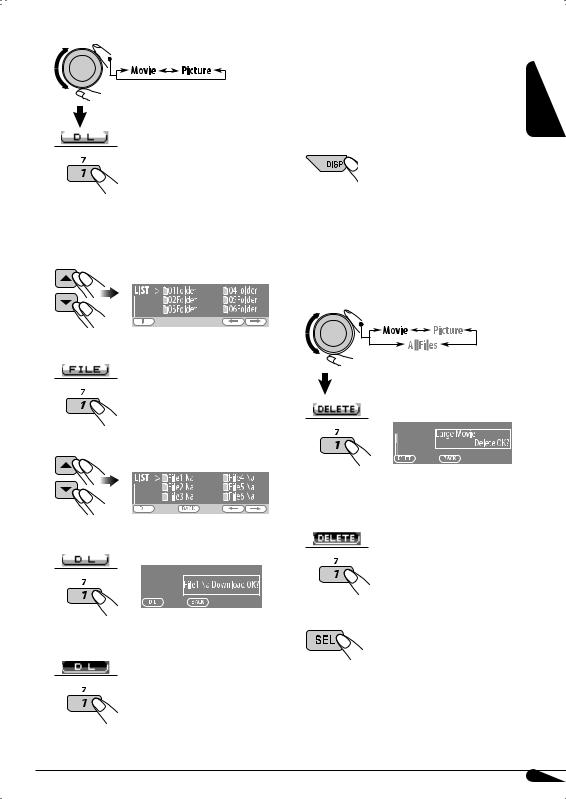
2
“File Check” appears and then the Folder List appears on the display.
3 Select a folder.
4 Display the File List.
5 Select a file.
6 Confirm the selection.
EX.: When “File1 Na” is selected
7 Download the file.
8• To download more pictures from the same folder, repeat steps 5 to 7.
•To download more pictures from another folder, press number button 3 ( ). Then, repeat steps 3 to 7.
). Then, repeat steps 3 to 7.
9 Exit from the setting.
 Deleting the files
Deleting the files
Deleting the stored animation
1Follow steps 2 to 4 on page 22.
• In step 3, select “Delete.”
2
EX.: When “LARGE” is selected in step 4 on page 22
3 Delete the animation.
4 Exit from the setting.
ENGLISH
23
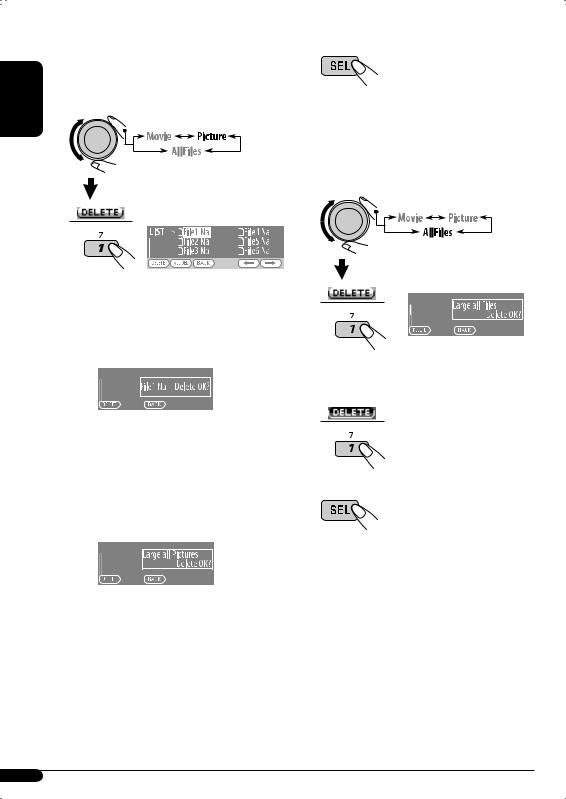
ENGLISH
Deleting the stored pictures |
4 Exit from the setting. |
1 Follow steps 2 to 4 on page 22. |
|
• In step 3, select “Delete.” |
|
2
The File List appears on the display.
3• To delete one of the stored pictures
1 Use 5/ ∞to select a file. Then, press number button 1 ( ) to confirm the selection.
) to confirm the selection.
EX.: When “File1 Na” is selected
2Press number button 1 ( ) to delete the selected file.
) to delete the selected file.
3Repeat steps 1 and 2 to delete more pictures.
•To delete all the stored pictures
1 Press number button 2 ( ).
).
Deleting all the stored files
1Follow steps 2 to 4 on page 22.
• In step 3, select “Delete.”
2
EX.: When “LARGE” is selected in step 4 on page 22
3 Delete all the stored files.
4 Exit from the setting.
EX.: When “LARGE” is selected in step 4 on page 22
2Press number button 1 ( ) to delete all the stored pictures.
) to delete all the stored pictures.
24
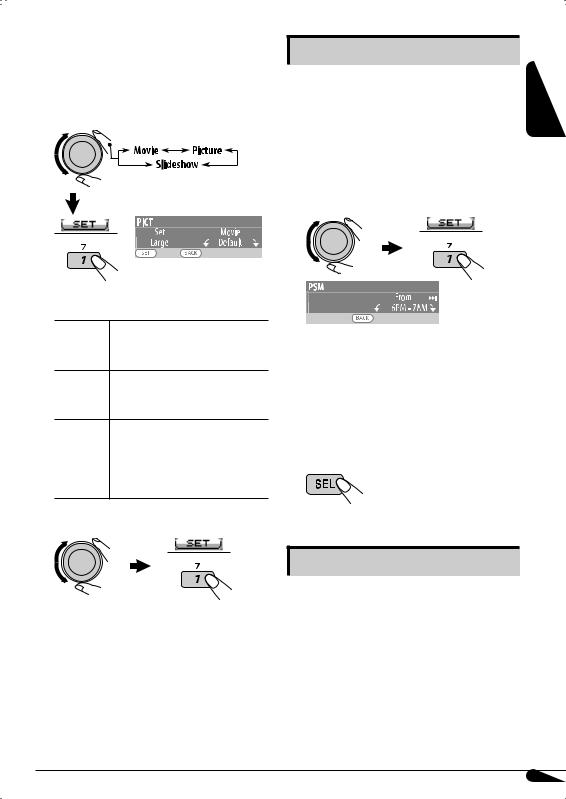
 Activating the downloaded files
Activating the downloaded files
1Follow steps 2 to 4 on page 22.
• In step 3, select “Set.”
2 Select the display type.
Setting the time for dimmer
•When  appears on the display, you can move back to the previous display by pressing number button 3.
appears on the display, you can move back to the previous display by pressing number button 3.
1Follow steps 1 to 3 on page 18.
•In step 2, select “DISPLAY.”
•In step 3, select “Dimmer.”
2 Select “Time Set.”
ENGLISH
EX.: When “LARGE” is selected in step 4 on page 22 and “Movie” is selected
Movie Your edited animation stored in “Movie” is activated. \Go to step 3.
Picture One of your edited still images stored in “Picture” is activated. \Go to step 3.
Slideshow All stored still images are activated and shown in sequence (UserSlide).
•If no still image is stored, beeps sound.
3Adjust the dimmer time.
1 Turn the control dial to set the dimmer time.
2Press ¢ to select “To.” Then, turn the control dial to set the dimmer end time.
to select “To.” Then, turn the control dial to set the dimmer end time.
4 Exit from the setting.
3Select a file.*
The unit returns to the playback display.
•To display the activated files, see page 8.
*If no still image or no animation is stored, you can only select “Default.”
Changing the display color
You can select your favorite display color for each source (or all sources).
•When  appears on the display, you can move back to the previous display by pressing number button 3.
appears on the display, you can move back to the previous display by pressing number button 3.
Continued on next page...
25

|
Setting the display color |
ENGLISH |
1 Follow steps 1 to 3 on page 18. |
• In step 2, select “COLOR.”
• In step 3, select “Color Sel.”
2
3 Select a source.
All Source*1 OCD OChanger (or Ext In*2) OLINE IN*3OUSB*4 OFM OAM OSirius*4/XM*4 OIpod*4/
D.PLAYER*4 O(back to the beginning)
*1 When you select “All Source,” you can use the same color for all the sources.
*2 Depends on the “Ext Input” setting, see page 21.
*3 Only for KD-AR870.
*4 Displayed only when the target component is connected.
4 Select a color.
Every*4 OAqua OSky OSea OLeaves OGrass OApple ORose OAmber OHoney OViolet OGrape OPale O User*5 O(back to the beginning)
*4 The color changes every 2 seconds.
*5 The user-edited colors—“Day Color” and “NightColor” will be applied (see right column for details).
5Repeat steps 3 and 4 to select the color for each source (except when selecting “All Source” in step 3).
6 Exit from the setting.
 Creating your own color—User Color
Creating your own color—User Color
You can create your own colors—“Day Color” or “NightColor.”
1Follow steps 1 to 3 on page 18.
•In step 2, select “COLOR.”
•In step 3, select “Color Set.”
2 Select “Day Color” or “NightColor.”
3 Select a primary color.
4Adjust the level (+00 to +11) of the selected primary color.
26
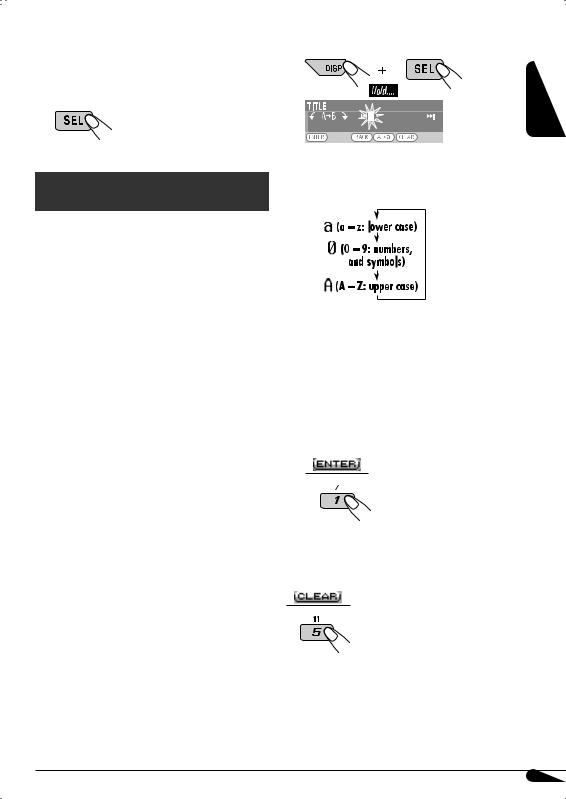
5Repeat steps 3 and 4 to adjust other primary colors.
6 Exit from the setting.
Title assignment
You can assign titles to station frequencies, CDs (both in the unit and the CD changer), and external components (Ext In).
Sources |
Maximum number of |
|
characters |
||
|
||
|
|
|
FM/AM tuner |
Up to 10 characters (up to 30 |
|
|
station frequencies including |
|
|
both FM and AM) |
|
CDs/CD-CH*1 |
Up to 32 characters (up to |
|
|
30 discs) |
|
External |
Up to 8 characters |
|
components |
|
|
(“EXT IN” or |
|
|
“LINE IN”*2) |
|
*1 You cannot assign a title to a CD Text or MP3/WMA/USB.
*2 Only for KD-AR870.
•When  appears on the display, you can move back to the previous display by pressing number button 3.
appears on the display, you can move back to the previous display by pressing number button 3.
1Select the sources.
•For FM/AM tuner: Tune into a station.
•For CDs in this unit: Insert a CD.
•For CDs in the CD changer: Select “CD-CH,” then select a disc number.
•For external components: Select “EXT IN” (see page 21) or “LINE IN.”
2 Display the TITLE input screen.
ENGLISH
3 Assign a title.
1 Press number button 4 ( ) repeatedly to select a character set.
) repeatedly to select a character set.
2Turn the control dial to select a character.
• For available characters, see page 38.
3 Use  4/¢
4/¢ to move to the next (or previous) character position.
to move to the next (or previous) character position.
4Repeat steps 1 to 3 until you finish entering the title.
4 Store the title.
To erase the entire title
In step 3 above...
27
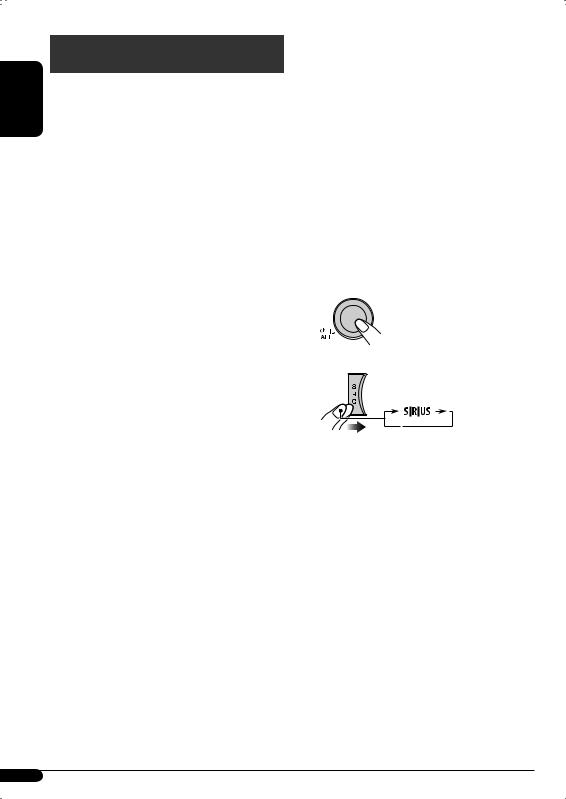
ENGLISH
Satellite radio operations
This unit is satellite (SAT) Radio Ready —compatible with both SIRIUS Satellite radio and XM Satellite radio.
Before operating your satellite radio:
•For connection, see Installation/Connection Manual (separate volume).
•Refer also to the Instructions supplied with your SIRIUS Satellite radio or XM Satellite radio.
•“SIRIUS ” and the SIRIUS dog logo are registered trademarks of SIRIUS Satellite Radio Inc.
•XM and its corresponding logos are registered trademarks of XM Satellite Radio Inc.
•“SAT Radio,” the SAT Radio logo and all related marks are trademarks of SIRIUS Satellite Radio Inc., and XM Satellite Radio, Inc.
 Listening to the satellite radio
Listening to the satellite radio
Connect either one of the following (separately purchased) to the CD changer jack on the rear of this unit.
•JVC SIRIUS radio DLP—Down Link Processor, for listening to the SIRIUS Satellite radio.
•XMDirect™ Universal Tuner Box—Using a JVC Smart Digital Adapter (XMDJVC100: not supplied), for listening to the XM Satellite radio.
GCI (Global Control Information) update:
•If channels are updated after subscription, updating starts automatically.
The following appears and no sound can be heard.
–For SIRIUS Satellite radio: “Channels Updating XX%* Completed”
–For XM Satellite radio: “UPDATING”
•Update takes a few minutes to complete.
•During update, you cannot operate your satellite radio.
*Changes every 20% of update is completion, (ex. 20%, 40%, 60%).
Activate your SIRIUS subscription after connection:
1
2
JVC DLP starts updating all the SIRIUS channels.
Once completed, JVC DLP tunes in to the preset channel, CH184.
3 Check your SIRIUS ID, see page 20.
4Contact SIRIUS on the internet at <http://activate.siriusradio.com/> to activate your subscription, or you can call SIRIUS toll-free at 1-888-539-
SIRIUS (7474).
“Subscription Updated Press Any Key to Continue” appears on the display once subscription has been completed.
28
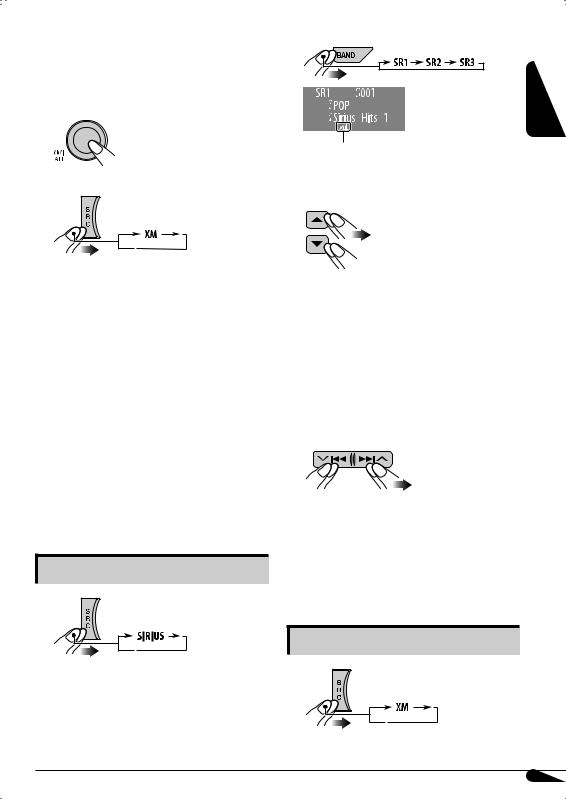
Activate your XM subscription after connection:
•Only channel 0, 1, and 247 are available before activation.
1
2
Signal strength bar increases as the receiving signal improves. If no signal is received, no bars are displayed.
ENGLISH
2
XMDirect™ Universal Tuner Box starts updating all the XM channels. “Channel 1” is tuned in automatically.
3Check your XM Satellite radio ID labelled on the casing of the
XMDirect™ Universal Tuner Box, or tune in to “Channel 0” (see page 30).
4Contact XM Satellite radio on the internet at <http://xmradio. comactivation/> to activate your
subscription, or you can call 1-800- XM-RADIO (1-800-967-2346).
Once completed, the unit tunes in to one of the available channels (Channel 4 or higher).
Listening to the SIRIUS Satellite radio
1
3Select a category.
You can tune in to all the channels of every category by selecting “ALL.”
Selecting a particular category (SPORTS, ENTERTAINMENT, etc.) allows you to enjoy only the channels from the selected category.
•Holding either of the buttons can display the category list (see page 31).
4 Select a channel for listening.
•Holding either of the buttons changes the channel rapidly.
•When changing the category or channel, invalid and unsubscribed channels are skipped.
Listening to the XM Satellite radio
1
Continued on next page...
29
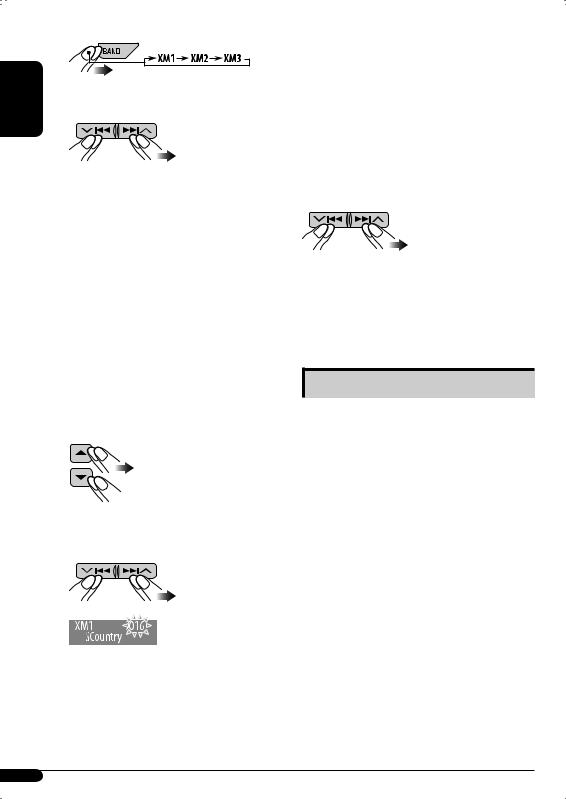
2
ENGLISH |
3 Select a channel for listening. |
|
|
|
• Holding either of the buttons changes the |
|
channel rapidly. |
If no operation is done for about 15 seconds, Category Search is canceled ( goes off).
goes off).
•While searching, invalid and unsubscribed channels are skipped.
 Checking the XM Satellite radio ID
Checking the XM Satellite radio ID
While selecting “XM1,” “XM2,” or “XM3,” select “Channel 0.”
 Searching for category/channel
Searching for category/channel
You can search for programs by category (Category Search) or channel number (Channel Search).
•In Category Search, you can tune in to the channels of the selected category. Category Search begins from the currently selected channel. The selected channel number flashes on the display.
•In Channel Search, you can tune in to all channels (including non-categorised channels).
1 Select a category (Category Search).
• For Channel Search, skip this step.
 appears on the display.
appears on the display.
2 Select a channel for listening.
EX.: When “Country” is selected for the Category Search
The display shows “RADIO ID ” and the 8-digit (alphanumeric) ID number.
To cancel the ID number display, select any channel other than “Channel 0.”
Storing stations in memory
You can preset six stations for each band.
•When  appears on the display, you can move back to the previous display by pressing number button 3.
appears on the display, you can move back to the previous display by pressing number button 3.
•When  /
/ appears on the display, you can move to the other lists by pressing number button 5 or 6 repeatedly.
appears on the display, you can move to the other lists by pressing number button 5 or 6 repeatedly.
Ex.: Storing a SIRIUS channel into preset
number 4 of the SR1 band.
1Tune in to a channel you want to listen to.
•By holding BAND button, the Preset Channel List will appear (go to step 5 on page 31).
30
